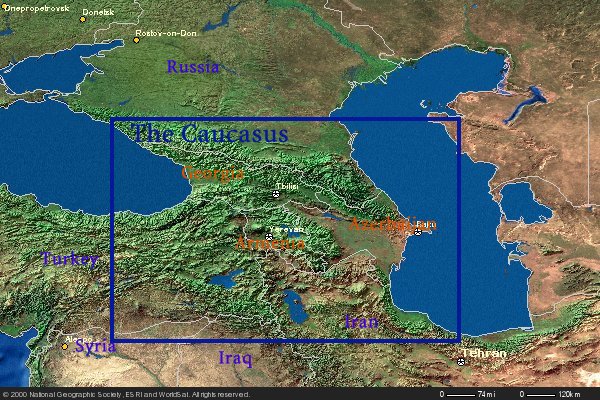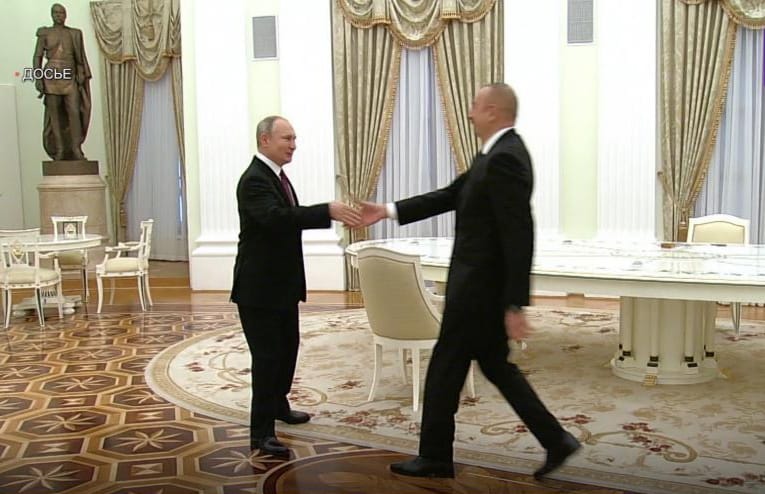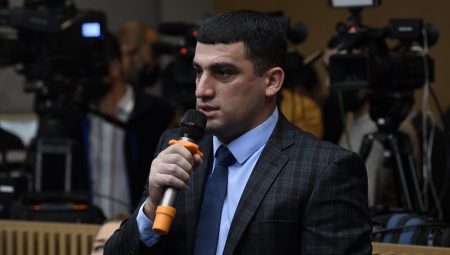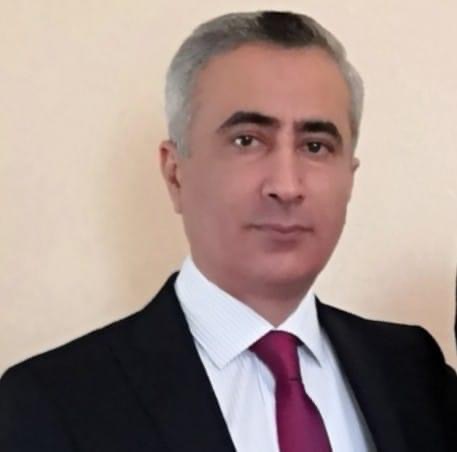Abstract
The South Caucasus in short term perspective (the next five year) will face a growing increase of Russian influence while witnessing a decrease in Western involvement. However, all three regional states will do their best to keep at least some Western involvement in the region, using it as leverage against Russia and as a source for support. Chinese influence will increase but China will not be able, or willing, to seriously challenge Russia’s position. Barring any major domestic turmoil in Russia, the status quo in Abkhazia and South Ossetia is guaranteed. There is a likelihood of military escalations by Azerbaijan over the contested region of Karabakh. However, full scale war with deployment of aviation, multiple launched rockets systems, and short/mid – range missiles is less likely.
Introduction
The South Caucasus is a part of the Post – Soviet space. Its geopolitical future is mainly determined by the overall developments in that part of the world, which also includes Central Asian republics as well as Ukraine, Belarus, and Moldova. Three key factors will influence the region’s geopolitics in short – term perspective (the next 5 years).
Growing Russian attempts to regain its full control over the post – soviet space as a buffer zone against alleged Western strategy to weaken and dismember Russia.
Weakened Western interest and involvement in the region due to political upheavals in the US and the EU. Specifically, in the US as a result of President Trump’s election, and in the EU, as a result of Brexit, the migrant crisis and a growing influence of forces who do not see the further enlargement of the EU as a viable option.
The emergence of China as a global power with insistent strategy to expand its influence in former soviet space.
All three internationally recognized states of the region, Armenia, Azerbaijan, Georgia as well as the disputed regions of Abkhazia, South Ossetia, and Nagorno Karabakh (considered by some as the Republic of Artsakh) have to deal with the dynamic evolution of this region. Each regional actor will make efforts to minimize potential negative impacts and retain flexibility to be able to respond to this rapidly changing environment.
Resurgent Russia is back
Since Vladimir Putin’s ascent to power in 2000, Russia has significantly increased its capacities to project power in its immediate neighborhood and beyond. Russia’s actions in Ukraine and Syria have proved that Russia, at least militarily, has returned into the ranks as a global power. The active use of hybrid warfare tactics including a successful mix of propaganda and misinformation has multiplied Russian capabilities to influence the political environment around the world. The ongoing investigation of alleged Russian meddling in the 2016 US elections is a vivid example of this reality.
However, Russian actions have created a backlash from the West. NATO significantly increased its defense capabilities on the Eastern Flank and the US launched the European Assurance Initiative. The US and the EU imposed economic sanctions on Russia and any hopes for a breakthrough in Russia’s relations with the West have become a remote possibility.
In this tense environment, Russia’s primary goal is to regain control over former Soviet Republics in order to use them as a buffer zone against alleged Western pressure on Russia. Key tools in this strategy are the Russian led military and economic integration projects – Collective Security Treaty Organization (CSTO) and Eurasian Economic Union (EAEU). Thus, Russia’s ultimate goal is to include all three internationally recognized states of the South Caucasus into the CSTO and EAEU. Armenia is already a member of those two organizations, so Russian efforts will be directed towards Azerbaijan and Georgia.
Russia has various tools at its disposal to pursue this goal. Russia will attempt to use the Nagorno – Karabakh conflict as leverage in its negotiations with Azerbaijan. Other options may include negotiations over the legal status of the Caspian Sea, and an exploitation of Azerbaijan’s vulnerability as a result of the Shia and Sunni radical movements. Russia will also seek to manipulate disagreements with Western institutions, especially with the Council of Europe, over the worsening human rights and rule of law situation in Azerbaijan to pull Azerbaijan closer to Moscow.
However, Azerbaijan will not be happy with these interventions. While Baku needs to establish a partnership with Russia to upgrade its army through large scale purchases of Russian modern weaponry; and given the level of influence Russia exerts on Armenia, good relations with Moscow are vital for the settlement of the Karabakh conflict. In the short – term, it is unlikely that Azerbaijan will be ready to enter either CSTO or EAEU. Current Azerbaijani leadership has no guarantees that such developments will not result in a Russian supported change of government. Given the Azerbaijan – West partnership in the energy and transportation sphere and Azerbaijan’s role in launching transit corridors that circumvent Russia, Moscow will most likely seek more loyal forces governing Azerbaijan. If Azerbaijan enters CSTO and EAEU, implementation of such a scenario will become more realistic.
Given the issues of Abkhazia and South Ossetia, the direct inclusion of Georgia into the Russian sphere of influence is problematic. However, Russia will seek to use its propaganda capabilities to discredit Euro – Atlantic institutions and prove the uselessness of the Georgia – EU Association Agreement as a pivotal tool to make changes in the lives of ordinary citizens. Discussions about the possibility of creating a confederative Georgia as an EAEU member, with the inclusion of Abkhazia and South Ossetia as the only possible way to restore Georgian territorial integrity, may be additional leverage Russia can exploit to expand pro – Russia sentiments within Georgian society. However, given the recent history of Georgian – Russian relations, especially the 2008 war, this type of radical shift in Georgian foreign and defense policy is unlikely.
Russia exerts a high level of control over Armenia. A Russian military base is deployed there, Armenia’s borders with Iran and Turkey are controlled by Russian border guards, and the two states have established a joint military unit and a joint air defense system. Key sectors of the Armenian economy are controlled by the Russian state or state affiliated companies. Thus, Russia’s main goal in Armenia is to maintain its current level of influence and prevent actions such as the signature of an Armenia – EU Comprehensive and Enhanced Partnership Agreement to jeopardize Russia’s dominant role in Armenia. Given the necessity to resist joint Azerbaijani – Turkish pressure over the Nagorno – Karabakh conflict, Armenia itself has little if any chances to radically change its current level of relations with Russia.
Another factor influencing the Russian strategy in the South Caucasus is time. Until now, Russian leadership has not managed to diversify its economy or successfully fight rampant and systemic corruption. Western sanctions have exerted additional pressure on Russia. The looming energy revolution, with a potential tangible decrease in oil and gas demand within the next 15– 20 years, makes Russia’s economic future more uncertain. In such circumstances, Russia most likely will take a more aggressive approach towards the post – soviet space by trying to achieve control more quickly. This may become one of the key foreign policy prerogatives of the Putin’s upcoming fourth Presidential term. Given the likely resistance from Azerbaijan and Georgia, this scenario will create tensions in the region over the short – term perspectives (the next 5 years).
Disengagement of the West
The collapse of the Soviet Union brought the South Caucasus into the realm of Western institutions. In the 1990s and during the first decade of the 21st century, the US, EU, and to a lesser degree NATO were actively involved in the region. They supported the transition from a totalitarian past to a democratic future by assisting regional states in their efforts to implement political, judicial, and economic reforms. Energy was also another key factor influencing Western policy in the region. The South Caucasus was perceived as both a source of, and a transit route for, Caspian gas and oil flow into Europe. However, in recent years Western enthusiasm has declined significantly. The reforms, with some exception in Georgia, did not bring about anticipated results. Azerbaijan and Armenia are stuck in a long transition with no clear timeframe and destination. Definitively, Azerbaijan’s human rights and rule of law situation has worsened; Armenia has also failed to manage qualitative change. Even Georgia, after Saakashvili, is in an uncertain situation. Neither the EU nor NATO will be able, or willing, to offer membership perspectives to either country in the foreseeable future. Thus, an Association Agreement signature with the EU is the highest possible result for Georgia’s decades long Euro – Atlantic aspirations, as the country is facing tough Russian pressure with no clear vision forward.
Hopes of Caspian energy resources breaking the EU’s dependence on Russian gas have also disappeared. Starting in late 2019, Azerbaijan will only be able to pump 10 bcm of gas per year to Southern Europe, which will not make a strategic shift in the EU’s energy balance. The idea of the Trans – Caspian pipeline bringing Turkmenistan gas to the EU via Azerbaijan has very little chance of implementation due to Iranian and Russian objections.
Additionally, Donald Trump’s election as the US President in November 2016 and an “America First” foreign policy concept put forward by the new US Administration makes the South Caucasus less relevant for Washington. The region currently has very little economic might to trigger attention. The Principled Realism approach embedded in the new US national security strategy (NSS) has significantly decreased the “democracy and reform promotion” agenda in US foreign policy, which was one of the key factors driving Washington’s involvement in the region. Though the new US NSS speaks about the necessity to counter Russian actions in its neighborhood, the main hot spot in US – Russia relations within the post – Soviet space is and will remain Ukraine. The US will continue some support to the South Caucasus through USAID and a few other instruments, but in short – term perspectives Washington’s involvement in the region will decrease.
The 2009 Eastern Partnership (EaP) program initiated by the EU was a step to increase European involvement in the South Caucasus. However, after almost 9 years of implementation, the EaP has not brought about significant changes. Only Georgia has signed the Association Agreement and there are no visible options for eventual EU membership. Meanwhile Armenia, after successfully finishing negotiations opted instead to join the Eurasian Economic Union. The signature of Armenia – EU Comprehensive and Enhanced Partnership Agreement in November 2017 is an interesting case proving that both EU and Russia are ready for experimentation. However, the CEPA will not bring any substantial geopolitical changes and Armenia will continue to be firmly anchored in Russia’s zone of influence.
Azerbaijan has been skeptical about the Association Agreement from the beginning. Both sides launched negotiations to sign a new agreement in February 2017, but Azerbaijan’s despicable human rights and rule of law situation, as well as international scandals of money laundering, effectively restricted any strategic partnership between Azerbaijan and the EU. The inability of Azerbaijan to play a critical role in EU energy diversification policies has also decreased EU interests in Baku.
Given the EU’s internal problems and challenges with Brexit, the growing threat of terrorism, a lack of a clear solution to the migrant crisis, and the issues in Catalonia, the upcoming years most likely will see diminishing EU involvement in the region.
China: New Kid on the Block
Since the beginning of the 21st century, China has passed through tremendous transformations with rapid economic growth and increasing geopolitical ambitions. The ascend to power of China’s current President, Xi Jinping in 2012 – 2013, gave China additional momentum. The harbinger of China’s global ambitions was the launch of the “One Belt, One Road (OBOR) initiative.” The allocation of over one trillion USD to infrastructure projects across the Eurasian continent to establish new routes connecting China with Europe is a clear sign that China has entered the global stage. In the Post – Soviet space, China has concentrated its efforts mainly on Central Asia, where Beijing has already outpaced Russia economically. However, the South Caucasus is also part of the zone of expanding Chinese influence. In contrast with the West, who qualifies its assistance on the implementation of political and economic reforms, China has no such agenda. All three internationally recognized states in the region are aiming for inclusion into China’s megaproject.
Georgia signed a Free Trade Agreement with Beijing in May 2017 and has already secured a $114 million USD loan from “One Belt, One Road” funds for road construction projects near Batumi, positioning itself as a transit route for Chinese goods to be delivered to Europe. The China – Kazakhstan – Caspian Sea – Azerbaijan – Georgian Black Sea – Europe route is actively being advertised by both Georgia and Azerbaijan.
Baku itself secured a 600 million USD loan from OBOR funds for the construction of Trans – Anatolian gas pipeline. The launch of Baku – Tbilisi – Kars (BTK) railway on October 30, 2017 is another argument for Baku to deepen its economic relations with China. BTK may be used for transportation of Chinese goods via Kazakhstan and Azerbaijan to Turkey and then either to Europe or the Middle East.
Armenia has its own hopes with China. In 2016 negotiations were launched to establish the “Persian Gulf – Black Sea” multimodal transport and transit corridor to link Iran with Europe via Armenia and Georgian Black Sea ports. If Armenia succeeds in joining the China – Iran sea transportation route with the “Persian Gulf – Black Sea” project, one of the main OBOR routes linking China with Europe will pass through Armenia.
On December 15, 2017 the Meghri Free Economic Zone (FEZ) was officially launched in Syunik region of Armenia, near the Armenia – Iran border. Armenia, as a member of the Eurasian Economic Union (EAEU), enjoys tariff free exports to the EAEU markets. Simultaneously, Armenia has access to the EU “Generalized Scheme of Preferences +” system, and is able to export goods categorized under the 6.400 tariff lines to the EU with zero, or reduced, tariff. Armenia is currently negotiating with several Chinese companies to secure their involvement in the Meghri FEZ. Armenia has proposed the use of FEZ as a launchpad to enter the Iranian market with zero tariffs once a Free Trade Agreement is signed between the EAEU and Iran. Another opportunity for Chinese companies is to export products with zero tariffs from Armenia to Southern Russia, given the geographical proximity of Armenia to the North Caucasus regions of Krasnodar and Stavropol.
However, the South Caucasus is not among China’s top foreign policy priorities. It will take years, if not decades, for China to seriously compete in the region with Russia. Though growing, China is unlikely to strategically shift the geopolitical balance of the South Caucasus in the coming years.
Turkey – Iran
Both Turkey and Iran view the region as a part of their sphere of interests. Given the anti – Iranian rhetoric of the new US administration, Iran’s main goal is to prevent the South Caucasus from being used a launchpad for any type of anti – Iranian activities by the US or Israel. The cornerstone of Turkey’s policy in the region will remain its alliance with Azerbaijan, isolation of Armenia, and the growth of Turkish economic involvement in Georgia. Given the deepening cooperation among the Russia – Iran – Turkey triangle in Syria as well as growing tensions between Turkey and the US, both Tehran and Ankara tacitly accept the increasing role of Moscow in the region.
Geopolitics of the South Caucasus in the short – term perspective
Armenia
The key issue influencing Armenia’s foreign and security policy is and will remain the Karabakh conflict. Since the failed Kazan summit in June 2011, no substantial talks have been underway for conflict settlement. Furthermore, the April 2016 Azerbaijan aggression made any chances for breakthrough in negotiations even less likely. Thus, Armenia will continue to counter joint Azerbaijan – Turkey pressure. The economic blockade imposed on Armenia will go on and given Azerbaijan’s perception of its victory in the April 2016 four – day war, the likelihood of new outbreaks of violence on the Karabakh – Azerbaijan line of contact remains high. Armenia will continue its efforts to upgrade its military capabilities with Russia as its main source of arms supply. Given growing Russian efforts to tighten its grip over the former Soviet space, Russian influence in Armenia will grow further, putting increasing restrictions on Armenia’s ability to implement independent foreign and security policy.
However, Armenia is in desperate need for systemic reforms and modernization. Accordingly, Yerevan will most likely lose in its competition with Azerbaijan in the long term. Russia is not able, and is not willing, to support Armenia in its modernization process as Russia perceives modernization as Westernization which may jeopardize its positions in Armenia. Russia is more interested in a weak Armenia, which has no alternatives but to beg for assistance from Moscow.
The only viable source of assistance for systemic reform and modernization is the West (the EU, US, NATO). In April 2018 Armenia will be transformed into a Parliamentary republic. Given the existence of weak political parties with no social base and the decisive role of leadership in Armenian politics, this political transition may create additional difficulties for effective state governance.
Given decreasing Western interests in the South Caucasus as well as overtly hostile Russian positions towards the West, Armenia needs a smart and balanced foreign policy. Armenia should not anger Russia and simultaneously try to receive as much support from the West as possible. The new agreement with the EU signed in November 2017 is a move in the right direction. However, a key issue in this process will be the political will of Armenia’s leadership to tackle their monopolistic economy and rampant corruption. Otherwise, Armenia will continue to lose its population with no hope for modernization and state recovery.
Azerbaijan
Azerbaijan’s main concern is domestic stability and regime survival amid a worsening economic situation due to the decline in oil production and prices. Until now, Azerbaijan has mainly failed in its efforts to diversify its economy and overcome its dependence on oil. Baku has to face growing pressure from Russia to move closer towards its northern neighbor including offers to enter EAEU and CSTO. Ultimately Azerbaijan will decline these offers but will use the process to manage its relations with Russia and put additional pressure on Armenia. Another key task for Azerbaijan is the increase of state transit potential. The official opening ceremony of the BTK railway in late 2017 was a significant move in that direction. The finalization of the North – South corridor linking the railroads of Iran, Azerbaijan and Russia and establishing a trade corridor connecting India and Northern Europe will be a key task for Azerbaijan in the coming years.
Azerbaijan will continue its efforts to launch the Southern Gas corridor to start the delivery of 10 bcm of gas per year to European markets, starting in 2019. However, growing authoritarianism and a worsening human rights situation will put additional pressure on Azerbaijan’s relations with the West. In 2018 or 2019, Azerbaijan will likely sign a new cooperation agreement with the EU, but it will not have a decisive role in improving Azerbaijan’s relations with the West.
Azerbaijan will continue its “war of attrition” strategy against Armenia in the context of the Karabakh conflict. The two pillars of this strategy are the blockade/isolation of Armenia as well as sniper warfare and subversive incursions along the Azerbaijan – Karabakh line of contact. Azerbaijan might also launch limited scale military operations along the border, similar to its April 2016 operation, to make additional land grabs or to divert Azerbaijani societies’ attention from domestic problems, in case of a sharp decline in living standards.
Georgia
Georgia is in the difficult process of reassessing its foreign and security policy. The country obviously has reached the limits of the Euro integration process by signing the Association Agreement with the EU and establishing several cooperation mechanisms with NATO. With almost zero chance of entering either the EU or NATO in the foreseeable future, uncertainty for future of relations with the West arise. Additionally, there is no clear vision to deal with Abkhazia and South Ossetia. Obviously, Georgia is not able to impose its control over these territories by force. Moreover, Georgia will be unable to counter Russian policy of “creeping annexation” in South Ossetia when Russian border guards were slowly moving fences deeper into Georgian territory. One option is to wait and hope for domestic turmoil in Russia during the Post–Putin transition. Another option is to collaborate with Russia for the possibility of creating some form of a confederation with Abkhazia and South Ossetia while entering the EAEU. Russia itself is actively promoting this idea in Georgia through pro – Russian forces like “Alliance of Patriots of Georgia”. However, the years of Saakashvili rule have created a majority within Georgian society who until now have rejected any rapprochement with Russia and are vying for deepening relations with the West, despite no prospective for EU or NATO membership.
Georgian authorities will try to revitalize their economy through an increase of Georgian transit capabilities. The opening of the BTK railway is a step in that direction. The “Persian Gulf – Black Sea” transport and transit corridor is another significant project for Georgia. Thus, Georgia’s short – term primary goal will be economic development with an attempt to attract new investments from both the West and China. Tbilisi will try to keep its dialogue channels open with Russia to avoid any deterioration in Abkhazia and South Ossetia.
Conclusions
The South Caucasus will face a growing increase of Russian influence while witnessing a decrease in Western involvement in the short term. Russia’s main efforts will aim to include Azerbaijan and Georgia in its institutionalized sphere of influence through membership into the Russian – led CSTO and EAEU. However, both Azerbaijan and Georgia are not interested in such a perspective. Baku will flirt with Russia on this issue in order to gain a negotiation advantage in the Karabakh conflict and to receive modern Russian weaponry. Georgia will attempt to keep Russia at a distance while simultaneously trying not to provoke Moscow and keep the current status quo in Abkhazia and South Ossetia. The overarching goal for Armenia is to not succumb to joint pressure from Azerbaijan and Turkey. As a result, Yerevan has to deepen its relations with Russia, thus increasing its dependence on Moscow.
All three internationally recognized states will do their best to keep at least some Western involvement in the region, using it as a leverage against Russia and as a source for financial and technical support. While China’s influence will increase, China will not be able, or willing, to seriously challenge Russia’s position. However, China will be able to gradually take the advantage of the vacuum created by Western disengagement.
Barring any major domestic turmoil in Russia, the status quo in Abkhazia and South Ossetia is guaranteed. There is a likelihood of military escalations by Azerbaijan over the Karabakh – Azerbaijan contested line. However, full scale war with deployment of aviation, multiple launched rockets systems, and short/mid – range missiles is less likely.
Dr. Benyamin Poghosyan is Vice President for Research – Head of the Institute for National Strategic Studies at the National Defence Research University in Armenia. In 2013 he was a Research Fellow at the US National Defense University. Dr. Poghosyan is a graduate from the US State Department Study of the US Institutes for Scholars Program on US National Security Policy Making. He holds a PhD in History from the Armenian National Academy of Sciences and is a graduate from the Tavitian Certificate Program on International Relations at Fletcher School of Law and Diplomacy. His primary research areas are geopolitics of the South Caucasus as well as US – Russian relations and their implications for the region.
By: Benyamin Poghosyan
Disclaimer: The views expressed are those of the author and do not reflect the official policy or position of the Government of Armenia, The Department of Defense, the Department of the Air Force, or the U.S. Government.
\https://overthehorizonmdos.com/2018/02/07/geopolitical-future-of-the-south-caucasus/






